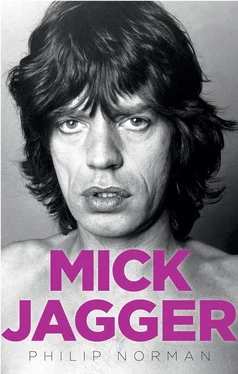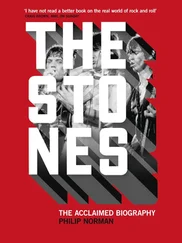Their only other contact with the recording industry was a friend of Ian Stewart’s named Glyn Johns, who worked for a small independent studio called IBC in Portland Place, owned by the BBC orchestra leader Eric Robinson. Johns was allowed to record any musicians he thought promising, and at his invitation the Stones taped five numbers from their stage act at IBC. In return, he received a six-month option to try to sell the demo tape to a major label.
Giorgio Gomelsky became the band’s de facto manager yet, with extraordinary selflessness, never tried to put them under contract or even keep them all to himself. Continuing the fishy theme (‘crawdaddy’ is Deep Southern slang for crayfish or langoustine), they also began playing regularly on Eel Pie Island, situated on a broad stretch of the Thames at Twickenham. The island’s main feature was a dilapidated grand hotel with a ballroom whose sprung wooden floor had been famous in the Charleston and Black Bottom era. Here, a local antiques dealer now put on weekend blues marathons, featuring the Stones in rotation with other superstars of the future, then unrecognisable as such. They included a Kingston Art College reject named Eric Clapton – at this stage so nervous that he could only play guitar sitting down – and a raspy-voiced trainee gravedigger from north London named Rod Stewart.
Gomelsky, besides, had other fish to fry. One of early 1963’s few talking points outside of the weather was that eccentrically barbered Liverpool band the Beatles, who had followed their mediocre début single with a smash hit, ‘Please Please Me’, and were whipping up teenage hysteria unknown since the early days of Elvis Presley. Gomelsky had first seen them playing seedy clubs in Hamburg a couple of years previously, and even then had thought them something way out of the ordinary. When ‘Please Please Me’ became a hit, he approached their manager, Brian Epstein, with the idea of making a documentary film about them.
Though the film proposal fell through, Gomelsky grew friendly enough with the Beatles to get them out to the Crawdaddy one Sunday night when the Rollin’ Stones were playing. Despite the enormous difference in their status, the Liverpudlians and the southern boys immediately hit it off – and, surprisingly, discovered musical roots in common. The Beatles had played American R&B cover versions for years before John Lennon and Paul McCartney began writing original songs; they had also been just as edgy and aggressive as the Stones onstage before Epstein put them into matching shiny suits and made them bow and smile. Lennon, never comfortable about paying this price for success, appeared positively envious of the freedom Mick, Brian and Keith enjoyed as nobodies.
Later, the Beatles visited 102 Edith Grove, pronouncing it almost palatial compared with their own former living conditions behind the screen of a porno cinema in Hamburg’s red-light district. The rock ’n’ roll-obsessed Lennon turned out to know almost nothing about the Stones’ blues heroes, and had never heard a Jimmy Reed record until Mick played him Reed’s ‘I’ll Change My Style’. When, a few days later, the Beatles appeared in a BBC-sponsored ‘Pop Prom’ at the Royal Albert Hall, they invited Mick, Keith and Brian to come along and visit them backstage. To avoid having to pay for tickets, the three borrowed guitars from the Beatles’ equipment and passed themselves off as roadies. For the only time in his life, Mick found himself in a crowd of screaming fans who were completely unaware of his presence.
MOST YOUNG MEN of this era, whatever their calling, expected to be engaged by their late teens and married by the age of twenty-one. And in the beautiful, bright and fascinatingly connected Cleo Sylvestre nineteen-year-old Mick thought he had already found the woman for him. There would, of course, be huge problems in taking their presently casual (and still platonic) relationship to a more permanent level. Interracial matches were still exceedingly rare in Britain, particularly among the middle class, and heavy opposition could be expected from both his family and Cleo’s. However, he was prepared to face down any amount of disapproval and prejudice. As a first step, he wanted Cleo to come to Dartford and meet his family, certain that even his mother would be instantly captivated by her.
But Cleo did not feel nearly ready for such a commitment. She had only just left school and was about to begin studying at a teacher-training college near Richmond. She also had an inbuilt nervousness about marriage – and men – having witnessed stormy and at times violent rows between her own parents before their separation. ‘I told Mick it had nothing to do with how I felt about him,’ she recalls. ‘It was just that the time wasn’t right. I wanted us still to be friends, but he said he couldn’t bear for it to be just on that level.’
The heartbreak, though real enough, was not to be of long duration. One night in early 1963, the Rollin’ Stones were playing yet another Thames-side blues club, the Ricky-Tick, hard by the battlements of the royal castle at Windsor. When Mick launched into Bo Diddley’s ‘Pretty Thing’ (‘let me buy you a wedding ring / let me hear the choir sing . . .’), his bandmates knew exactly whom it was aimed at.
Her name was Christine – aka Chrissie – Shrimpton; she was seventeen years old, but very different from the usual schoolgirl blues fan. Her older sister, the fashion model Jean Shrimpton, was growing increasingly famous through appearances in once-stuffy Vogue magazine, photographed by the young East Ender David Bailey. While Jean’s looks were coolly patrician – more fifties, in fact, than sixties – Chrissie was a quintessential young woman of now with her Alice-banded hair, ethereally pale face and thick black bush-baby eyes. The impassive pout essential to this look was enhanced by unusually wide and full lips, albeit not quite on the same scale as Mick’s.
Despite a noticeably posh accent and aura, Chrissie Shrimpton was less upper class than she appeared – and also more of a natural rebel than Mick had ever been. Her father was a self-made Buckinghamshire builder who had used his wealth to realise his dream of owning a farm in the high-priced countryside near Burnham. Though brought up with every luxury and given an expensive private education, Chrissie was an unruly spirit, constitutionally unable to submit to rules or authority. When she was fourteen, her convent school gave up the unequal struggle and asked her parents to remove her.
While fashion modelling took her sister Jean steadily up the social ladder, Chrissie consciously went the other way, dressing down like a beatnik and seeking out the raucous, proletarian R&B set. By day, she followed the only course open to young women without educational qualifications, training to be a shorthand typist at a secretarial college – her third – on London’s Oxford Street. At night, she roamed far from the Shrimptons’ Buckinghamshire farmhouse, becoming a regular at Eel Pie Island and the Crawdaddy, where she got to know both Rod Stewart and Eric Clapton well before first setting eyes on Mick and the Stones.
The various printed accounts of their first meeting are always set at the Windsor Ricky-Tick, with seventeen-year-old Chrissie – who sometimes cleared away glasses there in exchange for free admission – brazenly taking the initiative. In one version, she accepts a dare from a girlfriend to go up to Mick on the bandstand and ask him to kiss her; in another, the place is so packed that she can reach him only by crawling across the decorative fishing nets above the dance floor, helped along by people below in an early instance of crowd surfing.
Chrissie herself is unsure now whether the two of them first seriously locked eyes at the Ricky-Tick, at a nearby pub where the Stones sometimes played upstairs on Sunday afternoons, or at a place called the International Club, frequented by foreign au pair girls in nearby Maidenhead. ‘I was attracted to Mick originally because he looked like an actor named Doug Gibbons,’ she remembers. ‘At least, Doug was a prettier version of Mick. And I remember that when we first spoke his Cockney accent was so thick I could hardly understand him.’
Читать дальше












